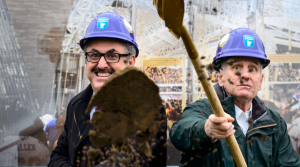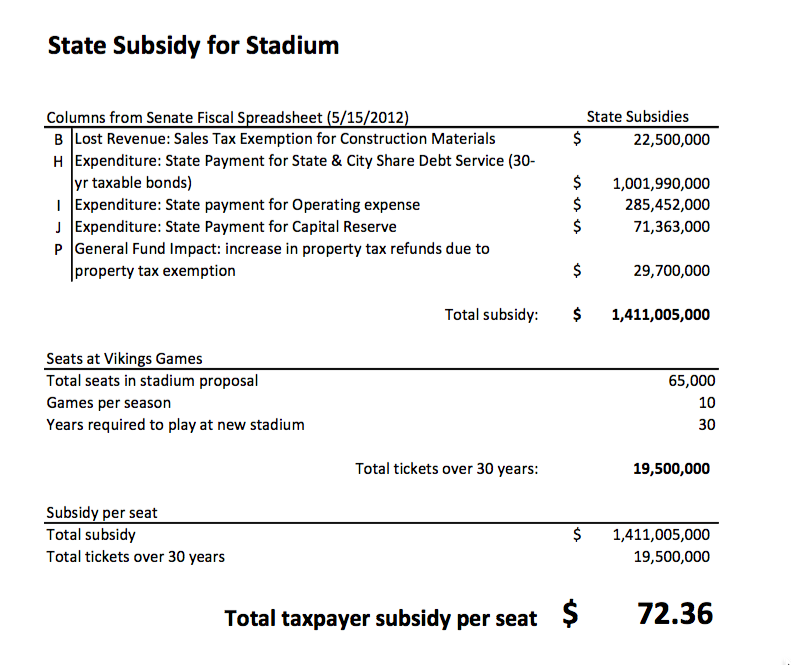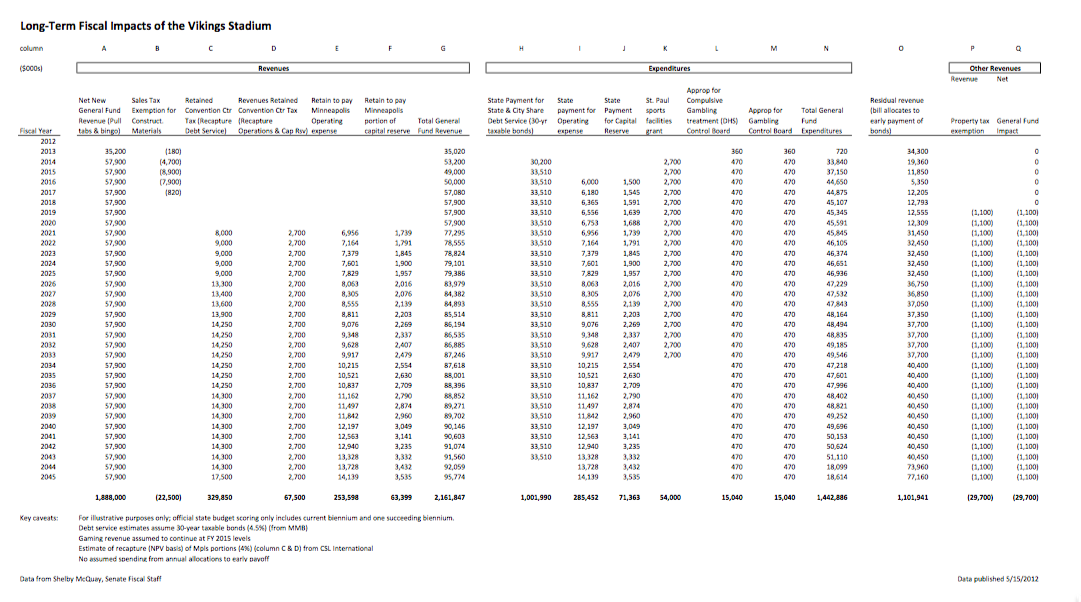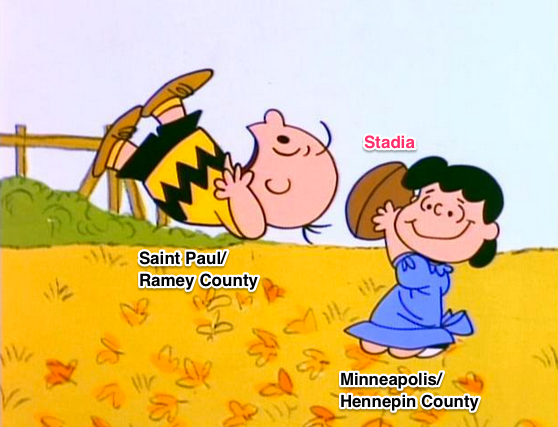
Billionaire Vikings owner Zygi Wilf is Minnesota’s Santa Claus. That’s essentially the message local news and sports coverage has hammered into Minnesotans’ heads over the last couple of years.
There has been a steady string of positive headlines promoting the Wilf’s stadium-related generosity: Twin Cities Business magazine: “Wilfs Commit $19.5 million More to New Vikings Stadium.” Minnesota Public Radio: “Vikings add 19.7 million to stadium contribution.” WCCO-TV: “Vikings, Wilfs To Commit to Additional $14M To New Stadium.” The Saint Paul Pioneer Press: “Vikings’ Zygi Wilf to increase stadium contribution.” The Star Tribune: “Vikings pony up $49 million for stadium accessories.”
Legendary Star Tribune sports columnist Sid Hartman regularly preaches about how fortunate we Minnesotans are to have the Wilfs lavishing us with additional stadium-related toys out of the goodness of their hearts. For instance, under the homer headline “Vikings Stadium Will Be Spectacular,” a typical Hartman column tells Minnesotans to “take your hat off to the Wilf family,” and then essentially turns his column over to Vikings executive Lester Bagley’s pro-Wilf spin:
“The Wilf family has put in an additional $95 million since the bill passed the Legislature, because a lot of teams and communities get to this point and they start to cut things [and] we don’t want to cut things. We want to add things and make sure this is the best stadium in the league.
The Legislature had us agree to $477 million in team/private dollars and since the bill passed, on top of that $477 million, the Wilfs have agreed to contribute an additional $95 million and counting.”
In addition to his newspaper columns, Mr. Hartman even more frequently carries the same kind of Wilf cheerleading to the powerful radio airwaves of WCCO-AM. KFAN-FM and 1500-ESPN also do their fair share to promote Zygi’s stadium contributions to their listeners.
The cumulative effect of all of this has been to paint a portrait of jolly old Zygi Claus and Lester the Elf continually delivering millions of dollars of new stadium toys to Minnesota’s football loving girls and boys.
I don’t blame reporters for those headlines. The budget increases happened, and reporters need to cover developments like that. Moreover, I’m glad that the Wilfs are paying the extra costs. It’s better than the alternative.
But as Mr. Wilf prepares to cut the ribbon for his new business asset later this summer, and have even more adoration heaped upon him by Mr. Hartman and others, it’s important to look at the broader context.
Others Paying “Owner’s Share”
Remember that the owner has had lots of help paying the so-called “owner’s share” of the stadium. The Vikings are getting hundreds of millions of dollars from a number of outside sources, such as a NFL loan program, seat licenses paid by fans, and enormous naming rights payments coming from U.S. Bank customers. As Minnesota Public Radio reported:
“If the team gets the NFL loan, sells naming rights and charges for personal seat licenses according to these estimates, it would have about $115 million of the original $427 million pledge yet to pay. Compared to the upfront price tag on the stadium of $975 million, the amount left is about 12 cents on the dollar.”
Note that this April 2012 MPR analysis was done prior to the Wilf’s increasing their stadium contributions by an additional $95 million or so. It also was done without solid numbers related to these three types of funding sources.
But details aside, the larger point remains: What the owner is actually paying is only a small fraction of what is described in news coverage as “the owner’s share.”
Star Tribune sports columnist and 1500ESPN radio analyst Patrick Reusse also wrote an excellent 1500ESPN blog post asserting that about $450 million of the Wilf’s share will be paid by someone other than the Wilfs. Reusse’s analysis was titled “Quite a Bonanza For Our Stadium Martyr.” However, the radio station appears to have removed the post.
“Worst Deal From Sports Team”
Mr. Wilf is the generous one? Really? Minnesota taxpayers are bearing a heavy burden for the stadium, because the Wilfs insisted on it, during a decade worth of legislative warfare. In naming the Twin Cities one of “5 cities getting the worst deals from sports teams,” MarketWatch asks:
“How do you get taxpayers to chip in $500 million on a more than $1 billion stadium when only one city, Indianapolis ($620 million), has ever paid that much?”
MarketWatch also notes that Minneapolitans “will end up paying $678 million over its 30-year payment plan once interest, operations and construction costs are factored in.”
I’m not informed enough about every stadium deal in the nation to say whether MarketWatch is correct that Minnesotans got one of the worst deals ever. But it is important to understand that Minnesota taxpayers are being extraordinarily generous to the Vikings owners, not the other way around.
Wilfs Are Takers, Not Givers
By any reasonable analysis, the Wilfs are the big takers in this scenario. They are not, as much of the news and sports coverage has implied or asserted, the big givers. After all, this luxurious new taxpayer subsidized stadium won’t make taxpayers’ wealthier, but it is already making the Wilf’s much wealthier.
Forbes magazine estimates that the Vikings franchise, which reportedly was purchased by the Wilfs for about $600 million in 2005, was worth $796 million in 2011, the year before the stadium subsidy was approved. By 2015, after the taxpayer subsidy was approved by the Minnesota Legislature and Governor Dayton, Forbes estimates the value of the Wilf’s business had spiked to $1.59 billion.
That’s a remarkably quick appreciation going to Zygi Claus’s bottom line in the post-stadium approval era. Add what the owners will be pocketing due to large increases in stadium-related revenue in the coming years, and it’s pretty clear that the Wilfs are making out like bandits.
Precise analysis is pretty much impossible on this subject, because executives are not nearly as forthcoming about details related to the loan, seat licenses and naming rights as they are about contributions. However, this is roughly what it looks like to me: Zygi Claus is investing something in the neighborhood of $200 million to see his business valuation increase by at least $800 million, and probably quite a bit more over time.
None of this is illegal, or all that unusual. But it also is not Santa Claus.
 Are Minnesota Vikings season ticket holders effectively government-dependent welfare queens? After all, a state legislator’s analysis finds that every Vikings ticket benefits from a taxpayer subsidy of over $72.
Are Minnesota Vikings season ticket holders effectively government-dependent welfare queens? After all, a state legislator’s analysis finds that every Vikings ticket benefits from a taxpayer subsidy of over $72. Critics may quibble with the specifics of the Marty analysis. But specifics aside, the undeniable fact remains that Minnesota taxpayers are on the hook for an enormous subsidy that looks to be much larger than the $498 million figure typically quoted during legislative debates.
Critics may quibble with the specifics of the Marty analysis. But specifics aside, the undeniable fact remains that Minnesota taxpayers are on the hook for an enormous subsidy that looks to be much larger than the $498 million figure typically quoted during legislative debates.



